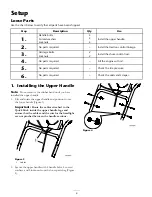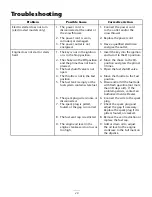
Storage
•
Gasoline vapors can explode.
•
Do not store gasoline more than 30 days.
•
Do not store the snowthrower in an enclosure
near an open flame.
•
Allow the engine to cool before storing it.
Preparing the Snowthrower
for Storage
1. On the last refueling of the year, add fuel stabilizer to
fresh fuel as directed by the engine manufacturer.
2. Run the engine for 10 minutes to distribute the
conditioned fuel through the fuel system.
3. Loosen the hose clamp that secures the fuel line to the
valve and slide the fuel line off the fuel shutoff valve.
4. Open the fuel shutoff valve and allow the fuel to drain
out of the fuel tank into an approved fuel container.
5. Install the fuel line onto the fuel shutoff valve and
secure it with a hose clamp.
6. Run the snowthrower until the engine stops from
running out of fuel.
7. Prime the engine and start it again.
8. Allow the engine to run until it stops. When you can no
longer start the engine, it is sufficiently dry.
9. Stop the engine and allow it to cool.
10. Remove the ignition key.
11. Disconnect the spark plug wire.
12. Remove the spark plug, add 1 oz. (30 ml) of oil through
the spark plug hole, and pull the starter rope
slowly
several times to distribute oil throughout the cylinder to
prevent cylinder corrosion during the off-season.
13. Loosely install the spark plug.
14. Dispose of any unused fuel properly. Recycle it
according to local codes, or use it in your automobile.
Note:
Do not store stabilized fuel for more than
90 days.
15. Clean the snowthrower thoroughly.
16. Tighten all loose screws, bolts, and locknuts. Repair or
replace any damaged parts.
Removing the Snowthrower
from Storage
1. Remove the spark plug and spin the engine rapidly using
the starter to blow the excess oil from the cylinder.
2. Install the spark plug by hand and then torque it to
15 ft-lb (20.4 N·m).
3. Connect the spark plug wire.
4. Perform the annual maintenance procedures as given in
the Recommended Maintenance Schedule.
19
Содержание 38621
Страница 22: ......































